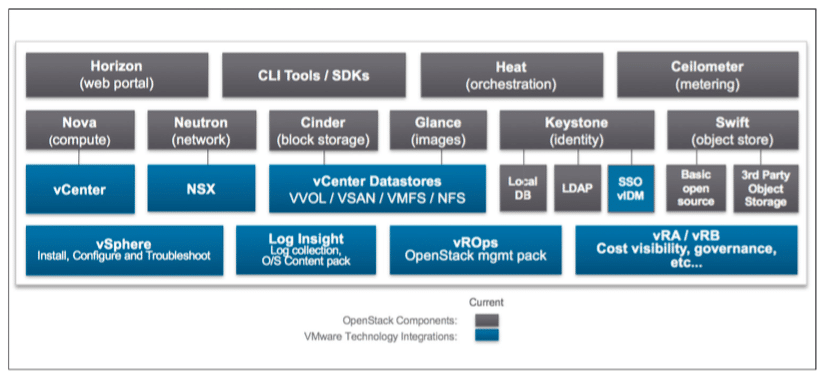![]() Today at the OpenStack Summit 2018 in Vancouver, VMware Inc. unveiled the latest release of its OpenStack distribution, which is now based on the OpenStack Queens release, VMware Integrated OpenStack 5. This new version will be available in both Carrier and Data Center Editions and introduces new features aimed at helping customers simplify, scale, and secure production OpenStack environments.
Today at the OpenStack Summit 2018 in Vancouver, VMware Inc. unveiled the latest release of its OpenStack distribution, which is now based on the OpenStack Queens release, VMware Integrated OpenStack 5. This new version will be available in both Carrier and Data Center Editions and introduces new features aimed at helping customers simplify, scale, and secure production OpenStack environments.
Today at the OpenStack Summit 2018 in Vancouver, VMware Inc. unveiled the latest release of its OpenStack distribution, which is now based on the OpenStack Queens release, VMware Integrated OpenStack 5. This new version will be available in both Carrier and Data Center Editions and introduces new features aimed at helping customers simplify, scale, and secure production OpenStack environments.

The first commercially available OpenStack distribution to comply with the 2018.02 interoperability guidelines, VMware Integrated OpenStack 5 packages, tests, and supports all major components of the distribution, including the full open source OpenStack code in a multi-cloud architecture. Customers looking to leverage VMware’s NFV and/or SDDC infrastructure will be able to do so faster and more efficiently with VMware Integrated OpenStack 5 automation and onboarding. Existing customers can upgrade seamlessly with the built-in upgrade capability, assuming they are eligible.
The Carrier edition specifically addresses the needs of CSPs deploying NFV-based network services spanning a host of current and 5G-ready use cases across core and edge.
Features include:
- Accelerated Data Plane Performance: will enable customers to achieve significant improvements in application response time, reduce network latencies, and breakthrough network performance via support of NSX Managed Virtual Distributed Switch in Enhanced Data Path mode and DPDK as well as optimized data plane techniques in VMware vSphere.
- Elastic Multi-Tenant Resource Scaling: will provide resource guarantee and resource isolation to each tenant to help ensure no other tenant can either consume from a given resource pool nor access the resource pool. It will also support elastic resource scaling allowing CSPs to add new resources dynamically across different vSphere clusters to adapt to traffic conditions or transition from pilot phase to production in place This will enable CSPs to isolate one type of workload/VNF from another, as well as assure resource availability as the load increases.
- OpenStack “In a Box” for 5G and Edge Computing: small footprint and highly resilient micro data center form factor will enable deployment “in a box” for 5G and edge computing. Customers will have full control over these micro data centers and apps at the edge via automated API-driven orchestration and lifecycle management. The solution will help tackle enterprise use cases such as utilities, oil and gas drilling platforms, point-of-sale applications, security cameras, and manufacturing plants and Telco oriented use cases such Multi-Access Edge Computing (MEC), latency sensitivity VNF deployments, and operational support systems (OSS).
- Self-Driving Operations and Service Assurance: will provides 360-degree visibility with real-time insights, root cause analysis (RCA) and remediation for OpenStack-based environments, including advanced workload analytics, predictive resource scheduling and balancing, and high-scale monitoring for VMs and containers across a single virtualized infrastructure manager (VIM).
On top of the Queens release, VMware added significant developments to support mission-critical workloads, across container and cloud-native application environments.
New capabilities include:
- Massive Scale: run up 500 hosts and 15,000 VMs in a single region, and will introduce support for multiple regions at once with monitoring and metrics at scale.
- High Availability for Mission-Critical Workloads: create snapshots, clones and backups of attached volumes to dramatically improve VM and application uptime via enhancements to the Cinder volume driver.
- Unified Virtualized Environment: ability to deploy and run both VM and container workloads on a single virtualized infrastructure manager (VIM) and with a single network fabric based on VMware NSX-T Data Center. This architecture will enable customers to seamlessly deploy hybrid workloads where some components run in containers while others run in VMs.
- Advanced Security: consolidate and simplify user and role management based on enhancements to Keystone, including the use of application credentials as well as system role assignment. VMware Integrated OpenStack 5 will take security to new levels with encryption of internal API traffic, Keystone to Keystone federation, and support for major identity management providers including VMware’s Identity Manager.
- Optimization and Standardization of DNS Services: scalable, on-demand DNS as a Service via Designate. Customers can auto-register any VM or Virtual Network Function (VNF) to a corporate approved DNS server instead of manually registering newly provisioned hosts through Designate.
- Improved User Interface: simplifies multi-tier and L3 routed network implementations via the latest Horizon dashboard. Ability to enable/disable NAT on the OpenStack NSX tenant router, and association to Neutron availability zones directly from the Horizon user interface, allows developers to tailor the network to fit their apps.
VMware is a premier sponsor of OpenStack for this year’s summit and will be at booth #A16 featuring demos of VMware Integrated OpenStack 5 as well as VMware NSX and VMware vCloud NFV.
Availability
VMware Integrated OpenStack 5 is expected to become available by August 3, 2018.
Sign up for the StorageReview newsletter

